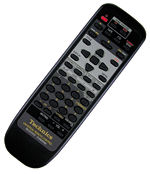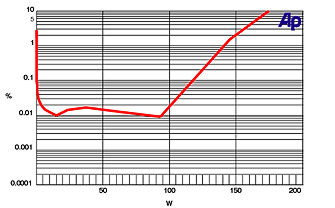Face Off: Budget Receivers Technics SA-DX930
With their line of affordable receivers, Technics has managed to put themselves back in the A/V receiver game. According to Matsushita (parent company of Technics and Panasonic) the SA-DX930 is one of the best-selling A/V receivers in its price category. With a well-recognized name like Technics and Dolby Digital/DTS processing, I can see why.
 I must admit that SA-DX930 actually looked and felt every bit as inexpensive as its $399 price tag suggests. The chassis itself is a little flimsy, and the use of inexpensive knobs on the front doesn't do anything to enhance the aesthetics of the receiver at all. Looking on the back and you'll find all the typical analog inputs and outputs, but no 6-channel input, and just like the Yamaha, the Technics has one coaxial digital input and two Toslink optical digital inputs. Unfortunately, speaker connections are made using spring clips for all the channels. The remote supplied with the unit is nothing special, but it can be set up to operate other components. I had no major issues with its operation, except for the fact that you have to walk up to the unit's front to select speaker size, which isn't too much of a hassle, just a little annoying.
I must admit that SA-DX930 actually looked and felt every bit as inexpensive as its $399 price tag suggests. The chassis itself is a little flimsy, and the use of inexpensive knobs on the front doesn't do anything to enhance the aesthetics of the receiver at all. Looking on the back and you'll find all the typical analog inputs and outputs, but no 6-channel input, and just like the Yamaha, the Technics has one coaxial digital input and two Toslink optical digital inputs. Unfortunately, speaker connections are made using spring clips for all the channels. The remote supplied with the unit is nothing special, but it can be set up to operate other components. I had no major issues with its operation, except for the fact that you have to walk up to the unit's front to select speaker size, which isn't too much of a hassle, just a little annoying.
 Before we talk about the performance of this receiver, in Technics' defense, I have to say the first receiver they sent us, we sent back because it was nonfunctional. They sent us another receiver that still had a few glitches that under normal circumstances would prompt us to send the receiver back for another sample. However, we felt that these glitches wouldn't effect the performance of the gear, and under the time constraints, we decided to go ahead and review it.
Before we talk about the performance of this receiver, in Technics' defense, I have to say the first receiver they sent us, we sent back because it was nonfunctional. They sent us another receiver that still had a few glitches that under normal circumstances would prompt us to send the receiver back for another sample. However, we felt that these glitches wouldn't effect the performance of the gear, and under the time constraints, we decided to go ahead and review it.
It was clear that the Technics receiver wasn't our favorite. We all declared unanimously that it couldn't match the other receivers' level of performance. "Vocals sounded colored and the dialogue was very muted," said Monica. Mike and I largely agreed, noting that the Technics lacked the other receivers' dynamics and detail. Mike summed it up best by calling the Technics "neighbor friendly." In other words, it was somewhat dynamic on two-channel music, but when I asked the receiver to reproduce the same dynamics into five channels, it all but gave up. I tried turning the volume up really loud but it didn't help.
 I decided that I probably wasn't being very fair to the Technics receiver by asking it to run all of the speakers full range (even though the Kenwood was able to do this with no problem, and they're both rated at 100 watts per channel). Most people who would buy this receiver would undoubtedly hook it up to a sub/sat system, so the next day I gave the Technics another go, this time running the speakers small with a subwoofer. What a difference a day makes! The Technics suddenly seemed to spring to life, although not quite as much as I'd have hoped. The SA-DX930 was still not as dynamic as the other receivers were, but I certainly wouldn't call its performance wimpy. Unfortunately Monica and Mike couldn't join me the next day, so I only speak for myself when I say that on its own the Technics is a good-sounding receiver, but when compared with the competition in this Face Off, it falls a tad short.
I decided that I probably wasn't being very fair to the Technics receiver by asking it to run all of the speakers full range (even though the Kenwood was able to do this with no problem, and they're both rated at 100 watts per channel). Most people who would buy this receiver would undoubtedly hook it up to a sub/sat system, so the next day I gave the Technics another go, this time running the speakers small with a subwoofer. What a difference a day makes! The Technics suddenly seemed to spring to life, although not quite as much as I'd have hoped. The SA-DX930 was still not as dynamic as the other receivers were, but I certainly wouldn't call its performance wimpy. Unfortunately Monica and Mike couldn't join me the next day, so I only speak for myself when I say that on its own the Technics is a good-sounding receiver, but when compared with the competition in this Face Off, it falls a tad short.
Highlights
• Benefits from the backup of a powered subwoofer
• Run those speakers small!


HT Labs Measures: Technics SA-DX930
The above measurement shows that the SA-DX930's left amplifier channel, with two channels driving 8-ohm loads, began clipping at 0.009% distortion and 93.1 watts. The amp reaches 0.1% distortion at 117.4 watts and 1% distortion at 140.9 watts, as shown above. Into 4 ohms, the amplifier begins clipping at 109.2 watts and reaches 0.1% distortion at 144.9 watts and 1% distortion at 186.9 watts.
The analog frequency response was +/-0.21 dB from 20 Hz to 20 kHz. The response dropped to -0.58 dB at 10 Hz and to -1.35 dB at 50 kHz. Crosstalk was -58.8 dB from left to right at 1 kHz and -58.1 dB from right to left at 1 kHz. THD+N from the amplifier was less than 0.03% at 1 kHz with 2.83 volts output.
From the Dolby Digital input to the loudspeaker outputs, the left, center, and surround channels are all flat, +/-0.84 dB from 20 Hz to 20 kHz. From the Dolby Digital input to the line-level output, the LFE channel is +0.2 dB at 20 Hz and reaches the upper 6-dB down point at 208 Hz.—AJ





























































